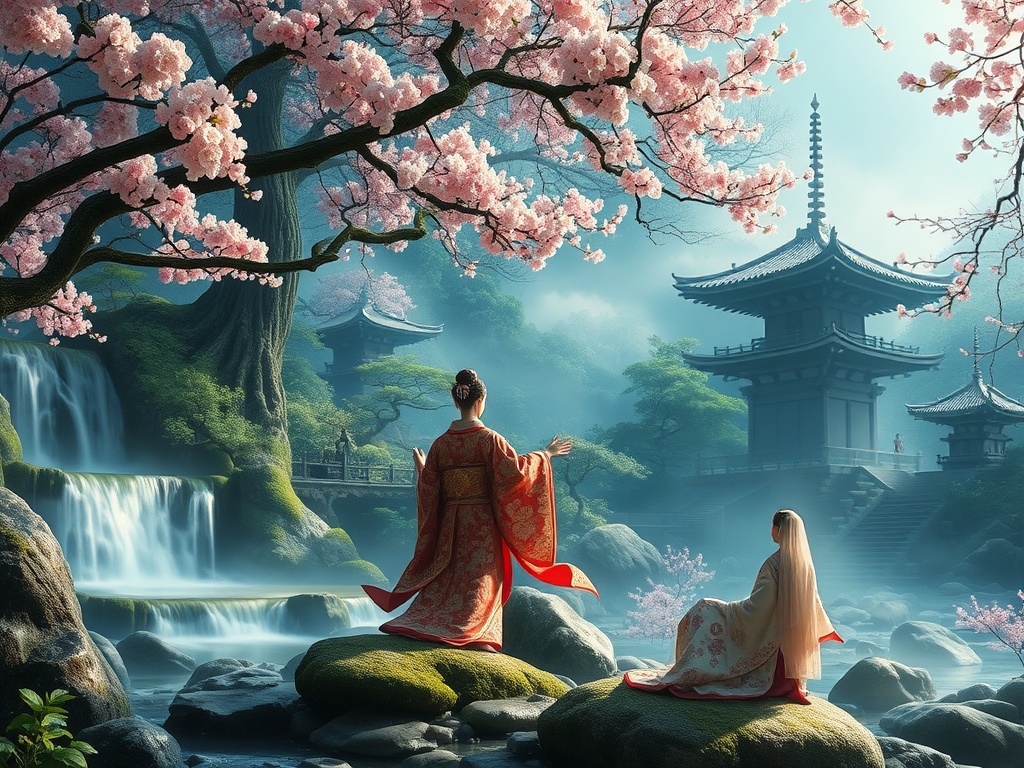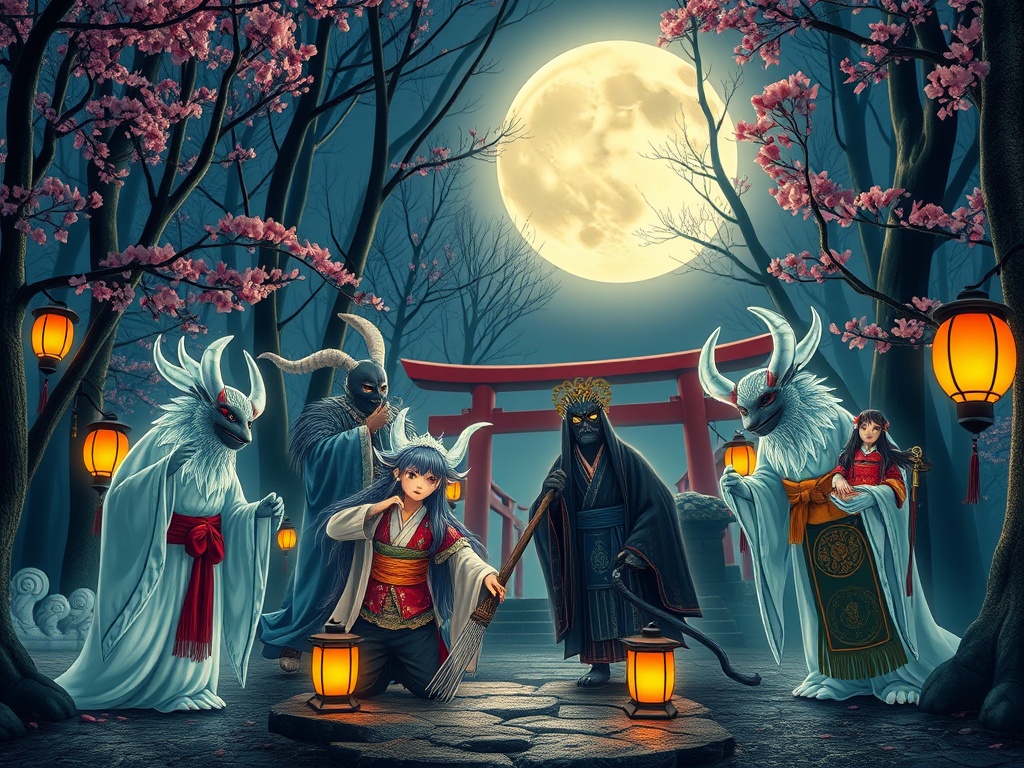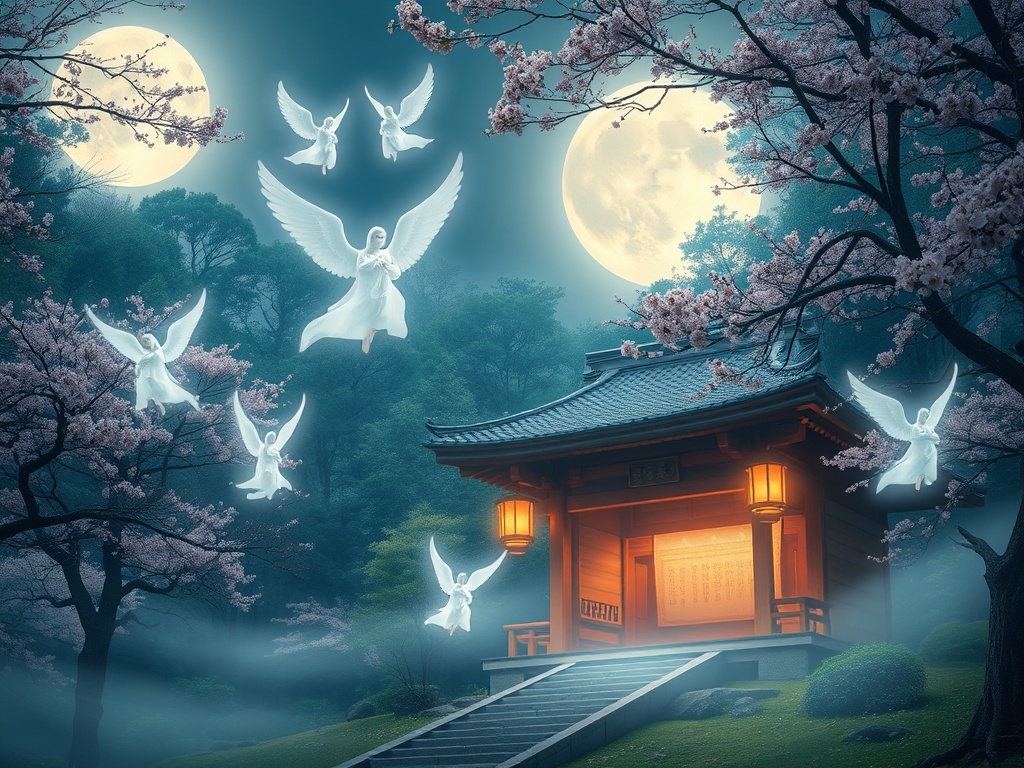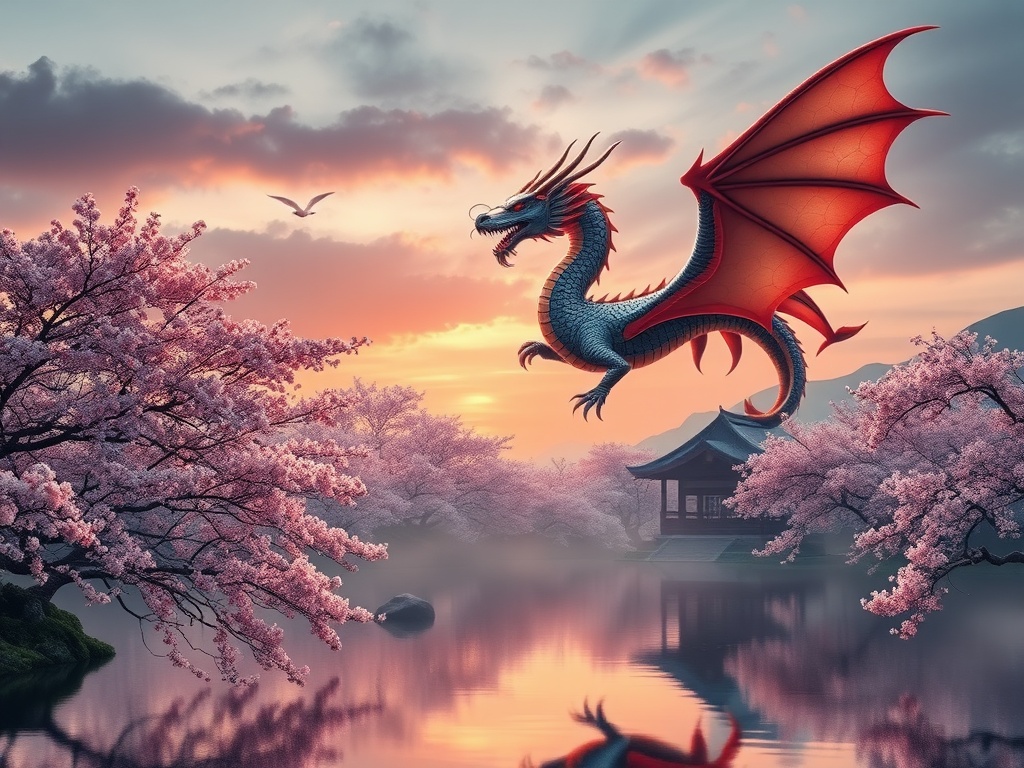Enchanting Yokai: Dive into the Mystical World of Japanese Spirits
Win a Free Trip to Japan!
Experience cherry blossoms and ancient temples
Embark on an unforgettable journey through Japan’s mystical realm, where the ancient and the arcane intertwine in the form of Yokai—enigmatic beings that capture the imagination of those who dare to explore. For travelers seeking the extraordinary, these spirits offer a window into the soul of Japanese folklore, an aspect of the culture that remains as vibrant today as it was centuries ago. From the picturesque landscapes of rural Japan to the bustling streets of its cities, Yokai are said to dwell in every shadow, whispering tales of mystery and wonder.
When venturing into the world of Yokai, knowing where to find them is half the adventure. Each spirit is said to inhabit a specific type of location, enriching the cultural tapestry of Japan. Here are a few notable Yokai and the places they’re believed to roam:
- Kappa: Often found near ponds and rivers, these water-dwelling creatures are mischievous yet fascinating. Visit the serene waters of Tono, Iwate Prefecture, for a chance encounter.
- Tengu: Dwellers of the mountain forests, Tengu are both feared and revered. The sacred mountains of Kurama near Kyoto offer a glimpse into their ethereal domain.
- Rokurokubi: Known for their ability to stretch their necks, these spirits are said to haunt quiet, traditional inns known as ryokans. Experience their eerie presence in the enchanting town of Takayama.
Japanese culture celebrates these mystical beings with vibrant festivals that bring the spirit world to life. These events are a must-see for any traveler eager to experience Japanese folklore firsthand:
| Festival Name | Location | Highlights |
|---|---|---|
| Yokai Parade | Kyoto | A grand parade featuring costumed participants impersonating various Yokai. |
| Tono Yokai Festival | Tono, Iwate | Traditional dances and stories that narrate the legends of local Yokai. |
| Obon Matsuri | Nationwide | A spiritual festival where families honor ancestral spirits, believed to be accompanied by Yokai. |
Whether you’re a thrill-seeker or a cultural enthusiast, the Yokai offer a unique lens through which to view Japan—a land where the past and present converge in the form of spirits and stories.
Divine Wonders: Meet the Celestial Guardians of Japan’s Sacred Shrines
As you venture deeper into Japan’s heart, you’ll find that the country’s spiritual landscape is not only inhabited by the mysterious Yokai but is also under the watchful gaze of divine guardians. These celestial beings, known as Kami, are revered across the nation and hold a significant place in the tapestry of Japanese spirituality. Each shrine is a testament to their presence, offering a sanctuary where the divine and the mortal worlds converge.
Visitors to Japan are often captivated by the serene beauty of its sacred shrines, where the atmosphere is imbued with an ancient mysticism that invites contemplation and reverence. These shrines, scattered across the country, are more than just places of worship—they are gateways to understanding the rich spiritual heritage of Japan. As you explore these hallowed grounds, you’ll encounter stories of Kami that have been passed down through generations, each tale adding to the mystique of these divine wonders.
In the vibrant city of Kyoto, the Fushimi Inari Taisha stands as one of the most iconic shrines dedicated to the Kami of rice and prosperity, Inari. The shrine is renowned for its thousands of red torii gates that create a mesmerizing path through the wooded hills. As you walk beneath these gates, you may feel the presence of fox spirits, messengers of Inari, believed to bestow blessings upon those who visit.
Further north, the island of Kyushu offers the majestic Takachiho Shrine, a place steeped in myth and legend. It is here that the sun goddess Amaterasu is said to have hidden in a cave, bringing darkness to the world until she was coaxed out by the other deities. This shrine is a place of profound tranquility, where visitors can witness traditional Kagura dances that reenact these ancient stories.
For those seeking a deeper connection with Japan’s divine heritage, embarking on a pilgrimage to these sacred sites is a transformative experience. The Kumano Kodo, a network of ancient pilgrimage routes in the Kii Peninsula, invites travelers to immerse themselves in the natural beauty and spiritual essence of the land. Along the way, you’ll encounter shrines dedicated to the Three Grand Shrines of Kumano, each a repository of spiritual wisdom and power.
As you traverse these paths, you’ll discover that the journey is as important as the destination. The act of walking in the footsteps of countless pilgrims before you offers a unique opportunity to reflect and reconnect with the divine. Whether it’s the quiet contemplation at a secluded shrine or the vibrant energy of a bustling temple festival, Japan’s celestial guardians continue to inspire awe and wonder in all who seek their presence.
Legendary Creatures: Unveiling the Myths Behind Japan’s Magical Deities
Japan, a land where the mystical and the mythical coalesce in harmony, offers a rich tapestry of legendary creatures that are as captivating as the sacred Kami and enigmatic Yokai. These magical deities, often influenced by ancient Shinto and Buddhist beliefs, encapsulate the essence of Japan’s spiritual narrative, drawing travelers into a world where the unseen becomes palpable. Each creature carries a story, a lesson, or a mystery, etched into the fabric of Japan’s cultural heritage.
Enigmatic Dragons: Guardians of Wisdom and Power
The dragon, or ryū, holds a place of great reverence in Japanese folklore. Unlike their Western counterparts, Japanese dragons are often seen as benevolent protectors, embodying wisdom, strength, and water’s life-giving properties. The dragon is said to dwell in deep lakes or ascend to the heavens, a bridge between the earthly and the divine. A visit to the Dragon Gate at the renowned Ryoan-ji Temple in Kyoto offers a glimpse into the symbolism and grace associated with these majestic beings. Here, the dragon is not just a creature but a spiritual guide, inviting introspection and awe.
The Elusive Kitsune: Fox Spirits of Transformation
The kitsune, or fox spirit, is a multifaceted deity, known for its ability to shape-shift and its association with the Kami Inari. These creatures are often portrayed as tricksters or protectors, depending on the tale. Inari shrines, scattered across Japan, frequently feature stone foxes as guardians, symbolizing prosperity and fertility. The Fushimi Inari Taisha in Kyoto, with its iconic red torii gates, is the perfect place to delve into the myths surrounding these mystical foxes. As you explore, you may feel the subtle presence of kitsune magic, a testament to the enduring belief in their transformative power.
Yurei: Spirits of Unfinished Business
Yurei, or wandering spirits, are akin to Western ghosts, yet they hold a distinctive place in Japanese culture. Often depicted in white funeral attire, these spirits are believed to be souls unable to find peace due to unresolved earthly matters. The Aoyama Cemetery in Tokyo, with its serene atmosphere and historical gravestones, provides an evocative setting to reflect on the stories of yurei. Whether seeking closure or delivering a message, these spirits remind us of the thin veil between the living and the departed, echoing the timeless connection between worlds.
Cultural Odyssey: How Japan’s Magic Deities Influence Traditions and Festivals
Step into a world where the mystical deities of Japan breathe life into vibrant traditions and festivities, illuminating the cultural landscape with their enchanting presence. These magical beings, deeply embedded in the fabric of Japanese heritage, are not just relics of folklore but active participants in the nation’s cultural narrative. Their influence can be seen in various customs and celebrations that attract travelers from around the world, eager to partake in the magical tapestry woven by these legendary figures.
Reverberating Through Rituals: The Deities’ Role in Celebrations
Across Japan, festivals and ceremonies pulsate with the energy of the divine, each one echoing the presence of magical deities who are believed to bestow blessings and prosperity. The Shinto practices, in particular, highlight the symbiotic relationship between humans and deities. During festivals like the Gion Matsuri in Kyoto, entire communities come together to honor these mystical entities, transforming the streets into a living tapestry of color and sound. Here, the divine is celebrated with grand processions and traditional music, a testament to the enduring allure of Japan’s celestial guardians.
Living Legends: Deities in Daily Life
Beyond the grand festivals, Japan’s magical deities influence daily life, weaving their essence into the everyday practices of the people. From the simple act of offering sake at a shrine to the intricate dances performed at Kagura ceremonies, these beings serve as an ever-present reminder of the spiritual continuum that connects past, present, and future. The deities’ stories, retold through generations, inspire not only reverence but also a profound respect for the natural world, encouraging a harmonious existence that resonates with many visitors.
Spiritual Landscapes: Explore the Sacred Sites Home to Japan’s Magic Deities
For those with a passion for travel and an admiration for the mystical, Japan offers an unparalleled opportunity to immerse oneself in a realm where the sacred and the supernatural merge seamlessly. The country’s spiritual landscapes are dotted with hallowed sites that not only serve as places of worship but also as gateways to the legends and lore that define Japan’s cultural essence. From the tranquil countryside to the vibrant city centers, these sites invite exploration and introspection, providing a unique lens through which to view the magical deities that inhabit this storied land.
Journey to the awe-inspiring Mount Haguro, part of the Dewa Sanzan, and discover a place where the past and present meet in a timeless embrace. This mountain is a revered pilgrimage destination, famed for its ancient pagoda and sacred cedar forests that whisper tales of the Yamabushi monks who once roamed these lands. As you walk the moss-covered stone paths, you’ll be enveloped by an atmosphere of serenity and mystery, a testament to the enduring presence of the divine.
Venture to the heart of Japanese spirituality at the Ise Grand Shrine, a place of profound importance dedicated to the sun goddess Amaterasu. Nestled in a lush forest, the shrine’s simplistic yet elegant architecture reflects the Shinto belief in purity and harmony with nature. Visitors often find themselves drawn to the sacred atmosphere, where the gentle rustling of leaves and the distant call of birds create a symphony that resonates with the spirit of the divine. Here, the ancient rituals and traditions continue to thrive, offering a glimpse into the spiritual continuity that shapes Japan’s cultural identity.
These spiritual landscapes are not merely destinations but are living embodiments of Japan’s rich cultural and spiritual heritage. As you explore these sacred sites, you’ll find yourself not just observing but participating in a narrative that has been woven over millennia. Each step you take is a journey through time, each whisper of the wind a reminder of the magic that permeates every corner of this enchanting land.
Tales of Transformation: Discover the Shape-Shifting Gods of Japanese Folklore
Step into the mesmerizing realm of Japanese folklore, where the boundaries between the known and the mystical are blurred by the presence of shape-shifting deities. These enigmatic gods, revered and feared, are masters of transformation, embodying the fluidity of nature itself. For travelers with a curiosity for the extraordinary, Japan’s shape-shifting gods offer an enthralling glimpse into a world where nothing is quite as it seems. From the bustling urban centers to the serene countryside, the tales of these deities weave a rich narrative that invites exploration and wonder.
In Japanese folklore, the ability to transform is not just a magical trait but a reflection of deeper spiritual truths. Deities like the Tanuki and Jorogumo captivate with their ability to change forms, each transformation carrying its own significance and lesson. These shape-shifters are often depicted as both mischievous and wise, their stories serving as allegories for the ever-changing nature of life and the universe.
The Tanuki, or raccoon dog, is a beloved figure known for its playful and cunning transformations. Often depicted with a jovial demeanor, the Tanuki uses its shape-shifting abilities to trick and entertain humans, symbolizing adaptability and resilience. Meanwhile, the Jorogumo, a spider spirit, enchants with her transformation into a beautiful woman, luring unsuspecting victims into her web. This deity’s tale serves as a cautionary reminder of the deceptive allure of appearances.
For those eager to delve into the mythical narratives of Japan’s shape-shifting deities, a visit to certain locales can enrich the experience. Below are some key destinations where the spirit of transformation is palpable:
- Shodoshima Island: Known for its Tanuki legends, this island offers a whimsical exploration of the raccoon dog’s transformative antics. Visitors can participate in local festivals celebrating the Tanuki’s playful spirit.
- Joren Falls, Izu Peninsula: This scenic spot is entwined with the legend of Jorogumo, offering breathtaking views and a chance to ponder the mysteries of the shape-shifting spider spirit.
The stories of Japan’s shape-shifting deities resonate with universal themes of change and transformation. As travelers immerse themselves in these tales, they are reminded of the power of adaptability and the beauty of embracing life’s uncertainties. Whether through the playful tricks of the Tanuki or the enchanting allure of the Jorogumo, these deities invite us to look beyond the surface and discover the transformative potential within ourselves.
Rituals and Offerings: Understanding the Worship of Japan’s Enigmatic Deities
Delve into the heart of Japan’s spiritual practices, where the worship of magical deities is a vibrant tapestry woven with rituals and offerings that have been passed down through generations. These sacred customs are more than just ceremonies; they are profound expressions of reverence, a bridge connecting the mortal realm with the divine. For travelers eager to immerse themselves in the mystique of Japan, understanding these rituals offers a deeper appreciation of the nation’s rich spiritual heritage.
Central to the worship of Japan’s deities is the act of making offerings, a gesture of respect and gratitude that fosters a connection with the divine. These offerings, known as saisen, can range from simple coins tossed into a shrine’s offering box to elaborate gifts of food, sake, and incense. Each offering holds symbolic significance, reflecting the desires and intentions of the worshiper. As you visit Japan’s sacred sites, you’ll notice the meticulous care with which these offerings are made, a testament to the enduring bond between humans and their celestial guardians.
Rituals play a pivotal role in the worship of Japan’s magical deities, serving as a conduit for spiritual communication and celebration. These ceremonies, often steeped in ancient traditions, are performed with precision and reverence. Travelers may witness rituals such as the purification (harae), where participants cleanse themselves of spiritual impurities before approaching the divine. The rhythmic chants and dances of Kagura performances, dedicated to the gods, offer a mesmerizing spectacle, inviting onlookers to partake in the spiritual harmony of the moment.
Essential Rituals and Offerings to Experience
- Saisen: Experience the tradition of offering coins at shrines, a practice believed to bring good fortune and blessings.
- Omikuji: Engage in the ritual of drawing fortune slips, a popular activity at many shrines, where the fates are revealed.
- Ema: Write your wishes on wooden plaques and hang them at the shrine, seeking the deities’ favor.
As you journey through Japan, these rituals and offerings offer not just a glimpse into the spiritual heart of the nation, but an invitation to participate in its timeless traditions. Each encounter with these sacred practices enriches the travel experience, leaving a lasting impression of Japan’s enchanting deities.
Guardians of Nature: How Magic Deities Protect Japan’s Untamed Wilderness
Embark on an exploration of Japan’s vast and untamed wilderness, where the presence of magic deities is felt in every whisper of the wind and rustle of the leaves. These celestial guardians are revered for their profound connection to nature, embodying the spirit of the land and safeguarding its pristine beauty. Travelers venturing into these natural sanctuaries will find themselves drawn into a world where the boundary between the earthly and the divine is beautifully blurred.
Deep within Japan’s lush woodlands, the kami of the forests stand as vigilant protectors of the natural world. These deities, often depicted as wise old spirits, are believed to inhabit ancient trees and sacred groves, watching over the flora and fauna that thrive under their care. In places like the Shirakami-Sanchi mountains, a UNESCO World Heritage site, visitors can immerse themselves in an ecosystem teeming with life, a testament to the guardianship of these ethereal beings. As you wander through these verdant landscapes, the presence of the forest kami offers a subtle reminder of the profound respect and harmony that exists between humans and nature in Japanese culture.
The rivers and mountains of Japan are not merely geographical features but are considered domains of powerful deities known to influence the elements. The majestic peaks of the Japanese Alps, with their snow-capped summits and crystal-clear streams, are home to Yama-no-kami, the mountain gods revered for their strength and majesty. Travelers who scale these heights often pay homage at shrines dedicated to these deities, seeking their protection and favor. Similarly, the river deities, or Mizuchi, are believed to control the flow of waters, ensuring the fertility of the land. The serene beauty of places like the Kurobe Gorge is a testament to their watchful presence, where the interplay of water and rock creates a mesmerizing tapestry of natural splendor.
For those with a passion for both travel and spirituality, Japan’s untamed wilderness offers an unparalleled opportunity to connect with the land’s magical deities. These guardians of nature not only protect the landscapes they inhabit but also invite travelers to discover the deep spiritual bond that ties the Japanese people to their environment. Each step into the wilderness is a step closer to understanding the sacred balance that defines this enchanting realm.



